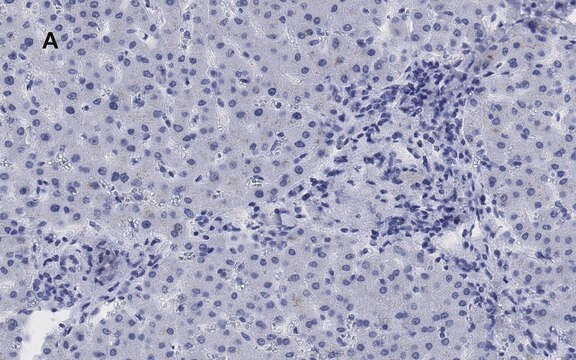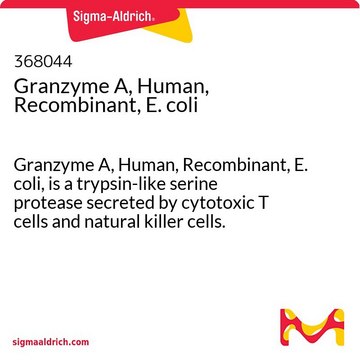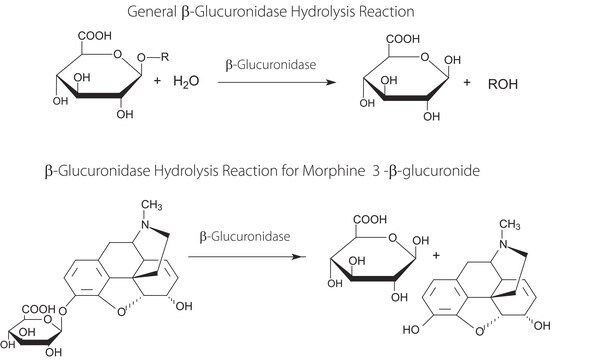GW22458A
Anti-LDLR antibody produced in chicken
affinity isolated antibody, buffered aqueous solution
Autenticatiper visualizzare i prezzi riservati alla tua organizzazione & contrattuali
About This Item
Prodotti consigliati
Origine biologica
chicken
Coniugato
unconjugated
Forma dell’anticorpo
affinity isolated antibody
Tipo di anticorpo
primary antibodies
Clone
polyclonal
Stato
buffered aqueous solution
Reattività contro le specie
mouse, human, rat
Produttore/marchio commerciale
Genway 15-288-22458A
tecniche
western blot: suitable
N° accesso NCBI
N° accesso UniProt
Condizioni di spedizione
wet ice
Temperatura di conservazione
−20°C
modifica post-traduzionali bersaglio
unmodified
Informazioni sul gene
human ... LDLR(3949)
Categorie correlate
Immunogeno
Immunogen Sequence: GI # 4504975, sequence 29-205
Recombinant low density lipoprotein receptor
Applicazioni
Anti-LDLR antibody produced in chicken is suitable for western blotting analysis at a dilution of 1:500, for tissue or cell staining at a dilution of 1:200.
Azioni biochim/fisiol
The Low-Density Lipoprotein (LDL) Receptor is a mosaic protein encoded by the LDLR gene in humans and belongs to the low density lipoprotein receptor gene family. It is located on chromosome number 19. LDL receptor is a mosaic protein constituiting of exons shared with different proteins. It is crucial for maintenance of cholesterol homeostasis. A deficiency in LDLR leads to hypercholesterolemia. LDLR is a type I transmembrane protein that needs O-glycosylation for stable expression at the cell surface. Mutation in this gene may cause familial hypercholesterolemia (FH), an autosomal dominant disease.
Stato fisico
Solution in phosphate buffered saline containing 0.02% sodium azide.
Esclusione di responsabilità
Unless otherwise stated in our catalog or other company documentation accompanying the product(s), our products are intended for research use only and are not to be used for any other purpose, which includes but is not limited to, unauthorized commercial uses, in vitro diagnostic uses, ex vivo or in vivo therapeutic uses or any type of consumption or application to humans or animals.
Non trovi il prodotto giusto?
Prova il nostro Motore di ricerca dei prodotti.
Raccomandato
N° Catalogo
Descrizione
Determinazione del prezzo
Codice della classe di stoccaggio
10 - Combustible liquids
Classe di pericolosità dell'acqua (WGK)
WGK 1
Punto d’infiammabilità (°F)
Not applicable
Punto d’infiammabilità (°C)
Not applicable
Dispositivi di protezione individuale
Eyeshields, Gloves, multi-purpose combination respirator cartridge (US)
Scegli una delle versioni più recenti:
Possiedi già questo prodotto?
I documenti relativi ai prodotti acquistati recentemente sono disponibili nell’Archivio dei documenti.
Nis Borbye Pedersen et al.
The Journal of biological chemistry, 289(25), 17312-17324 (2014-05-07)
The low density lipoprotein receptor (LDLR) is crucial for cholesterol homeostasis and deficiency in LDLR functions cause hypercholesterolemia. LDLR is a type I transmembrane protein that requires O-glycosylation for stable expression at the cell surface. It has previously been suggested
Jovan Nikolic et al.
Nature communications, 9(1), 1029-1029 (2018-03-14)
Vesicular stomatitis virus (VSV) is an oncolytic rhabdovirus and its glycoprotein G is widely used to pseudotype other viruses for gene therapy. Low-density lipoprotein receptor (LDL-R) serves as a major entry receptor for VSV. Here we report two crystal structures
Isabel De Castro-Orós et al.
BMC medical genomics, 7, 17-17 (2014-04-09)
GWAS have consistently revealed that LDLR locus variability influences LDL-cholesterol in general population. Severe LDLR mutations are responsible for familial hypercholesterolemia (FH). However, most primary hypercholesterolemias are polygenic diseases. Although Cis-regulatory regions might be the cause of LDL-cholesterol variability; an
Paulo Caleb Junior Lima Santos et al.
Atherosclerosis, 233(1), 206-210 (2014-02-18)
Familial hypercholesterolemia (FH) is an autosomal dominant disease caused mainly by LDLR mutations. This study assessed the influence of the presence and type of LDLR mutation on lipid profile and the response to lipid-lowering therapy in Brazilian patients with heterozygous
T C Südhof et al.
Science (New York, N.Y.), 228(4701), 815-822 (1985-05-17)
The multifunctional nature of coated pit receptors predicts that these proteins will contain multiple domains. To establish the genetic basis for these domains (LDL) receptor. This gene is more than 45 kilobases in length and contains 18 exons, most of
Il team dei nostri ricercatori vanta grande esperienza in tutte le aree della ricerca quali Life Science, scienza dei materiali, sintesi chimica, cromatografia, discipline analitiche, ecc..
Contatta l'Assistenza Tecnica.








